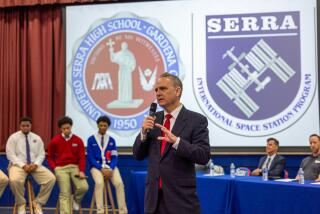Jason Project Scores Hits With Science Classes
It’s back to the ocean bottom for the Jason Project’s doughty child “argonauts,” who this year walked among Yellowstone’s bubbling geysers and watched scientists crawl into an ice cave above a volcano in Iceland.
During Jason IX next April, America’s science-classroom hit will return to its most popular setting--Davy Jones’ locker. Once again, millions of skeptical fourth- through 10th-graders may discover that science can be cool.
“My students sit on the edge of their seats and their mouths are open,” said Ann Ireland, a fourth-grade science teacher at Gates Elementary School in Davison, Mich. “It really makes them feel like scientists and brings them into the science community.”
With $5 million annual support from corporations and government, the Jason Project attempts to interest schoolchildren in science. Its sponsors hope that some might choose scientific or engineering careers.
Thousands of science teachers write their lesson plans around prepping students for Jason’s springtime “electronic field trip,” using videos, homework assignments and class projects--much of it supplied by the Jason Foundation.
Students follow the progress of the two-week Jason expedition either through interactive satellite hookups at 29 sites, through a classroom network, or via the Internet.
Come April, 350,000 students will interact with the expedition by satellite hookup, and 1 million students will watch through four statewide school networks, in Florida, Connecticut, Minnesota and Mississippi. Three million are expected to log onto Jason’s World Wide Web site.
It began in the late 1980s when undersea explorer Robert Ballard, a researcher at Woods Hole Oceanographic Institution on Cape Cod, Mass., was speaking in Texas about motivating children to learn about science. Take them on exciting expeditions, said Ballard, who located the Titanic at the bottom of the North Atlantic in 1985 and found the sunken German battleship Bismarck.
An Electronic Data Systems official was in the audience. He saw Ballard’s message as a solution to what EDS and other high-tech companies had been privately fretting about: Where would the next generation of scientists and engineers come from?
“With Jason, instead of going into journalism or law, kids are going to think about going into science,” said Bill Ritz, an EDS spokesman based in Herndon, Va.
Jason, a remote-controlled submarine that helped Ballard locate the Titanic, is named for the mythical Greek adventurer whose Argonauts were renowned for their quest for the Golden Fleece.
Last summer, the modern Jason helped Ballard locate--a half-mile deep--the wrecks of five ships that sailed when Rome ruled the world. The first Jason Project, in 1989, featured a successful hunt for a Phoenician trading vessel on the bottom of the Mediterranean.
Since then, students have traveled to Lake Ontario to map a sunken warship from the War of 1812; to the Galapagos Islands to retrace the footsteps of naturalist Charles Darwin; to the Sea of Cortez to study thermal vents; to the rain forests of Belize, and to Hawaii’s Mauna Kea volcano, among other destinations.
At the interactive sites, they drove a remote-controlled land rover on Mauna Kea and operated a video camera along a vertical runner high in Belize’s jungle canopy.
When Jason went to Yellowstone this year, students at the 29 interactive sites watched geysers, bubbling mudpots, buffalo and wolves on big-screen TVs. They questioned scientists at the site while maneuvering a remote video camera atop Old Faithful Lodge.
There have been setbacks. In 1991, a barge carrying $22 million worth of scientific gear sank on the way to the Galapagos Islands. The equipment, including the project’s namesake underwater probe, was lost, and there was no 1992 expedition.
Founding sponsor EDS and some of the nation’s largest corporations--IBM, Bechtel, Sprint, Hewlett-Packard, Eastman Kodak and McDonald’s--underwrite Jason with money, manpower and equipment. The Navy, the National Oceanic and Atmospheric Administration and other agencies also contribute their expertise.
Tim Armour, the Jason Project’s executive director, said Ballard, with his extensive National Geographic Society television experience, picked the first expeditions, but now they are more theme-oriented than place-oriented.
“We’ve always done well on oceans. There’s something innately interesting about them,” he said. Students also are partial to trips to rain forests and volcanoes, Armour said.
On a typical expedition, Ballard, who heads the new Institute for Exploration in Mystic, Conn., is accompanied by Navy officers, schoolteachers, corporate sponsors, students, academic researchers and National Geographic Society researchers.
Valerie Delarosa, 16, of Plano, Texas, was a student argonaut on the Jason VIII expedition to Yellowstone this year.
“When I was first picked, I thought all the people would be really smart. I’m not a total science person. I thought, god, would I be able to relate to these people?”
But she found her fellow argonauts were much like her. She made new friends, stayed at a lodge in Yellowstone and appeared on camera every day.
“After going, I got more serious about science,” she said. “I have a computer and would log onto the Web site. Kids would leave me questions and I would answer them.”
Ireland was a teacher argonaut in Yellowstone.
“It was an amazing experience and opportunity. I was so fortunate to be there,” she said. “I learned about vulcanology, I learned about geysers, the history of Yellowstone and its plants and animals.”
Armour said that was an unexpected dividend.
“Teachers say, ‘Now I remember why I wanted to become a teacher,’ ” he said. “We have become a professional development program for teachers.”
More to Read
Sign up for Essential California
The most important California stories and recommendations in your inbox every morning.
You may occasionally receive promotional content from the Los Angeles Times.










